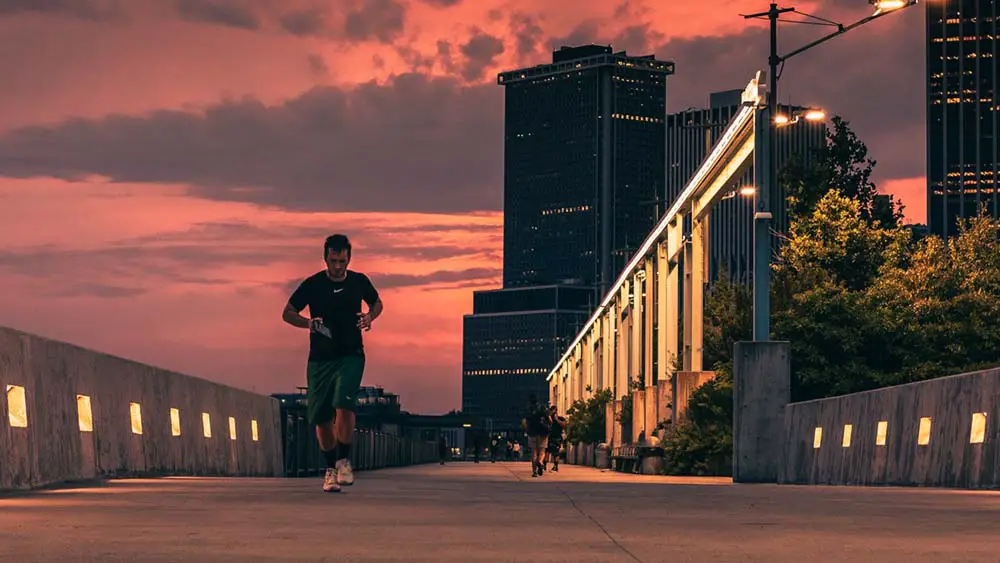This post contains affiliate links.

Running is a great exercise, however, not everyone has the luxury of running when there’s daylight. As a result, most runners run in the late afternoon or at night when it’s dark. But is running alone in the dark safe?
In general, it’s less safe to run alone in the dark than during daylight. Running alone in the dark puts you at greater risk of being attacked or hit by a vehicle. Always wear bright-colored shirts and run in populated areas if you wish to run alone in the dark.
But that doesn’t mean running alone in the dark is totally unsafe. There are a lot of safety issues that could easily be mitigated by simple planning. Ahead, we will look at some of the concerns that people have when running in the dark and 10 safety tips when running in the dark.
Is It Safe To Run Alone In The Dark?
Running is a great way to stay in shape for sedentary people and elite athletes alike. Hence, it is one of the most common types of exercise around the world.
But with busy schedules and responsibilities happening during the daytime, a lot of runners have no choice but to run alone at night time or early in the morning without the luxury of daylight.
Running in the dark exposes you to a number of risks including:
- Getting assaulted
- Getting hit by a driver
- Not seeing obstacles
- Less access to help
Getting assaulted is one of the most common concerns of runners when running alone in the dark. In fact, a Runner’s World research revealed 34% of female runners run only when there’s light and 54% of runners avoid the dark alleys whenever they needed to run without daylight in fear of getting harassed.
Runner’s fear of getting harassed or assaulted in the dark has a good basis. Statistics show that the prevalence of violent crimes being committed peaks at 9 pm—when it’s dark. And although getting physically assaulted while running at night doesn’t happen quite as often as we think, it’s still a valid concern.
There have been a number of cases of disappearance and assaults that happen to certain individuals when running alone at night. That said, it’s important to stay vigilant and aware of your surroundings every time you go for a run.
The less but more reasonable risk is getting run over by a vehicle in the dark. According to a statistic I found online, 122,000 runners get hit by a car annually. And that’s excluding minor injuries who decided not to report their accidents.
According to statistics, there are far more fatalities involving a pedestrian at night. Running in the dark exposes you to more risk because vehicle drivers have a harder time seeing you. Add the fact that more drunk drivers or sleepy drivers drive at night or at dawn.
I once spoke to a taxi driver about this and he told me that spotting runners at night on roads where lighting is a challenge. “You only spot the runner when he’s only a few feet in front of you and there’s little room to react“, notes the taxi driver.
I also had a personal experience driving in a secondary road where a lampost is broken and I hardly noticed a runner—who was wearing black—crossed the road running. Gladly, I was attentive enough to hit the breaks as soon as my headlight revealed him.
Another concern of running in the dark is the risk of getting injured due to environmental factors and not seeing them. That could be a step you didn’t see, a sharp edge, a branch from a tree, or a manhole that isn’t covered. Point is, the vicinity in the dark is lower, making it harder for you to react to obstacles quicker.
Then there’s the risk of getting no immediate help in case you meet an accident in one of your runs. In some rural areas, there are way fewer people around at night or early morning when it’s dark. Plus, it’s also harder to see you from afar making help harder to access.
10 Safety Tips For Running Alone In The Dark
The good thing is, although running during daylight is safer than running in the dark by yourself, there are some ways to make your solo runs in the dark a lot safer which we will talk about below.
1. Refrain From Listening To Music
Although drowning yourself in loud music is a fun way to spend your runs, you should ditch them when you’re running alone in the dark.
Listening to music makes you less aware of your surroundings thereby delaying your reaction time. And in some situations, that 1-second difference in reaction time could cost you your life.
Ditching the earbuds allows you to become more aware of your surroundings like a fast car in an intersection or the footsteps of a person following you.
Aside from that, there are also other benefits of running without music which include improving focus.
2. Wear Light-Colored and Reflective Clothing
One of the most common mistakes runners make is wearing dark-colored apparel when running at night. I get it, flashy neon green isn’t appealing for everybody, but, when you’re running in the dark, this is simply non-negotiable.
Choose clothes that are easily visible in the dark. This allows vehicle drivers to see you from afar and react quicker. Think of neon pink, green, orange, and white.
3. Familiarize Your Route and What’s Around It
Be familiar with every corner of your route. In case of emergency, you should be able to locate where you can get the nearest help, plot places to be extra careful, or find the shortest possible route back home.
Not every road is populated. So take note of police stations, populated areas, and any establishment where there’s security so you can sprint towards that area in case you feel in danger.
Also take note of terrain, intersections, and other obstacles in your route. That way, you can stay cautious when passing through those areas.
4. Inform Someone About Your Route And The Duration of Your Run
One of the best practices that I do whenever I head out for a run alone at night is to share my route and the duration of my run with a trusted family member or friend. That way, in case something happens, they can easily locate me or alert the authority.
Important note: Don’t forget to tell them that you’re done once you finish your run.
A close friend of mine made me her trustee and she forgot to tell me she was done running. I had to call someone from her household if she’d made it home 2 hours after her allotted time cause I didn’t get a text after she finished her run.
5. Run In Well-Lit And Populated Areas As Much As Possible
When choosing a route, run only in well-lit and populated areas. Crime is less likely to happen in front of other people.
This goes without saying: Avoid dark alleys where bad guys could be lurking and waiting on their prey.
6. Run In Parks or Popular Routes
Running in parks not only eliminates the risk of getting run over by a vehicle, but it’s also a place where there are runners or bystanders (usually people hanging out with friends and families) willing to help if you need one.
If there are no parks near you, consider running in popular routes where vehicles are more cautious and other runners might also be running.
7. Always Bring A Smartphone and ID
Although bringing a smartphone on a run could be a hassle for some, it could come in handy in an emergency situation.
Make sure your smartphone is charged. Run only in areas where the coverage is good. That way, you can easily call for help in case you need one.
Another important thing to bring is an identification card. It should have an emergency contact, name, address, and if possible, blood type, to make it easier for the rescuer to help you.
8. Run Against Traffic
It may sound counterintuitive to run in the direction of cars, but it’s actually safer that way.
According to a study in 2013, running towards traffic (on the opposite side of the road) decreases fatal and non-fatal accidents by up to 77%. That’s mainly because facing the traffic allows you to see incoming vehicles from afar.
9. Wear a Headlamp
Another helpful safety tip that everyone should consider is wearing a headlamp. It allows you to see the terrain more clearly. Furthermore, you also make yourself more visible for incoming traffic.
I get that not everyone wants to wear a headlamp because some can be heavy and uncomfortable. I’ve worn lamps that are either giving me headaches or suck at quality.
Recently, I found a headlamp I really like—the BioLite headlamp. It’s so light and comfortable that you barely notice it. It’s rechargeable and has a good battery life too. You can buy them on Amazon.
10. Don’t Post Your Route On Social Media (And Change Routes Frequently)
Routes and impressive metrics are common feed in social media. But you’re actually making it easier for someone wanting to harm you to plot their evil plan.
When you’re running at night, skip the trend and don’t post your routes. That way, whoever holds a grudge towards you won’t be able to use your route to plot something (although this rarely ever happens).
Also, change your routes. Don’t make the people around the area get familiar with your routine.
Conclusion
Although running when there is daylight is preferable for safety, it doesn’t mean that you should ditch running in the dark. Risks are present whichever time we go for a run, but staying at home and not getting good exercise is a lot more dangerous than running in the dark.
Reduce the risk by following the 10 safety tips I outlined above. Also, trust your instincts and use your common sense when going out for a run.
Lastly, I’ve mentioned that there is risk whenever you go out for a run. But there are things you can do to mitigate that risk. I’ve listed them all in another article.

